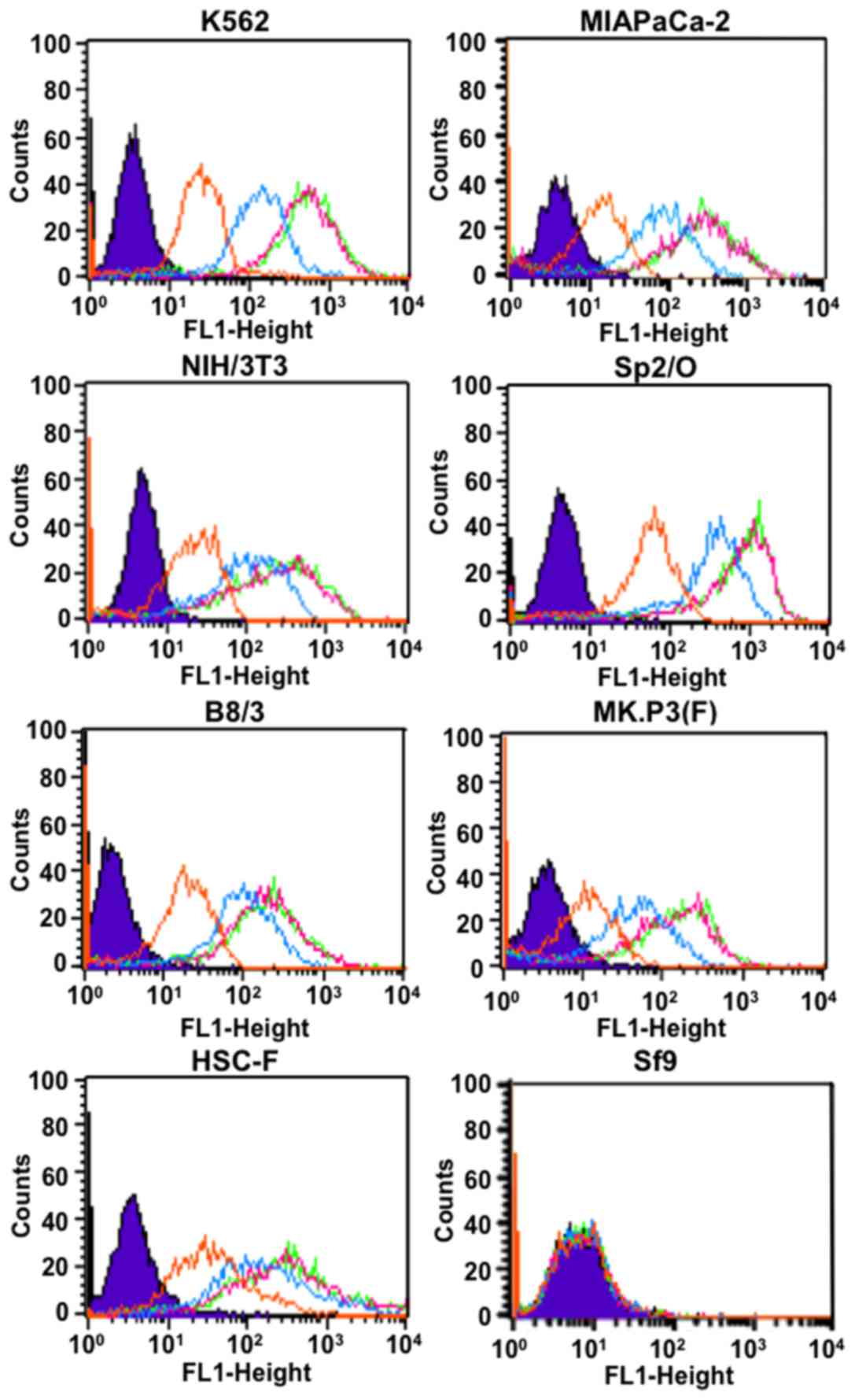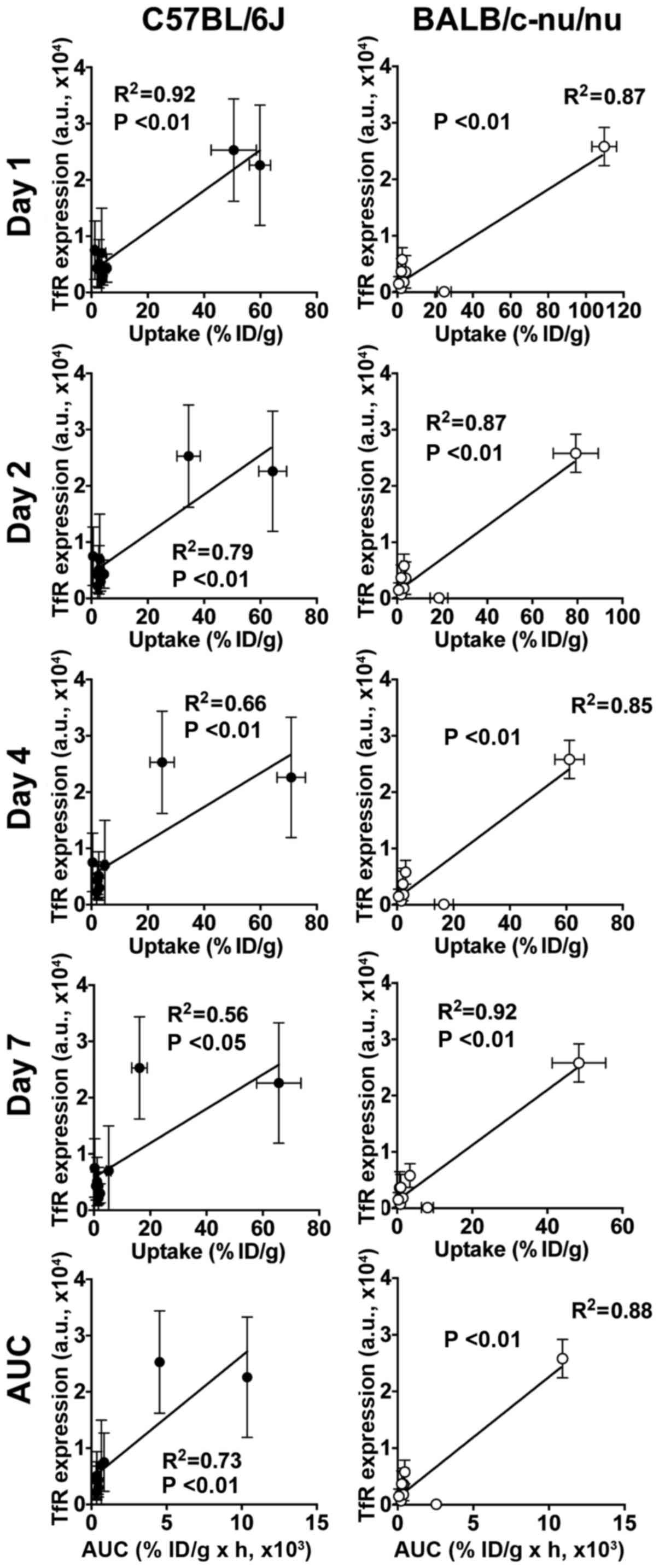|
1
|
Neckers LM and Trepel JB: Transferrin
receptor expression and the control of cell growth. Cancer Invest.
4:461–470. 1986. View Article : Google Scholar : PubMed/NCBI
|
|
2
|
Lesley JF and Schulte RJ: Inhibition of
cell growth by monoclonal anti-transferrin receptor antibodies. Mol
Cell Biol. 5:1814–1821. 1985. View Article : Google Scholar : PubMed/NCBI
|
|
3
|
Gatter KC, Brown G, Trowbridge IS,
Woolston RE and Mason DY: Transferrin receptors in human tissues:
Their distribution and possible clinical relevance. J Clin Pathol.
36:539–545. 1983. View Article : Google Scholar : PubMed/NCBI
|
|
4
|
Panaccio M, Zalcberg JR, Thompson CH,
Leyden MJ, Sullivan JR, Lichtenstein M and McKenzie IF:
Heterogeneity of the human transferrin receptor and use of
anti-transferrin receptor antibodies to detect tumours in vivo.
Immunol Cell Biol. 65:461–472. 1987. View Article : Google Scholar : PubMed/NCBI
|
|
5
|
Daniels TR, Delgado T, Rodríguez JA,
Helguera G and Penichet ML: The transferrin receptor part I:
Biology and targeting with cytotoxic antibodies for the treatment
of cancer. Clin Immunol. 121:144–158. 2006. View Article : Google Scholar : PubMed/NCBI
|
|
6
|
Ryschich E, Huszty G, Knaebel HP, Hartel
M, Büchler MW and Schmidt J: Transferrin receptor is a marker of
malignant phenotype in human pancreatic cancer and in
neuroendocrine carcinoma of the pancreas. Eur J Cancer.
40:1418–1422. 2004. View Article : Google Scholar : PubMed/NCBI
|
|
7
|
Daniels TR, Delgado T, Helguera G and
Penichet ML: The transferrin receptor part II: Targeted delivery of
therapeutic agents into cancer cells. Clin Immunol. 121:159–176.
2006. View Article : Google Scholar : PubMed/NCBI
|
|
8
|
Daniels TR, Bernabeu E, Rodríguez JA,
Patel S, Kozman M, Chiappetta DA, Holler E, Ljubimova JY, Helguera
G and Penichet ML: The transferrin receptor and the targeted
delivery of therapeutic agents against cancer. Biochim Biophys
Acta. 1820:291–317. 2012. View Article : Google Scholar : PubMed/NCBI
|
|
9
|
Sugyo A, Tsuji AB, Sudo H, Okada M,
Koizumi M, Satoh H, Kurosawa G, Kurosawa Y and Saga T: Evaluation
of efficacy of radioimmunotherapy with 90Y-labeled fully human
anti-transferrin receptor monoclonal antibody in pancreatic cancer
mouse models. PLoS One. 10:e0123761–e17. 2015. View Article : Google Scholar : PubMed/NCBI
|
|
10
|
Akahori Y, Kurosawa G, Sumitomo M, Morita
M, Muramatsu C, Eguchi K, Tanaka M, Suzuki K, Sugiura M, Iba Y, et
al: Isolation of antigen/antibody complexes through organic solvent
(ICOS) method. Biochem Biophys Res Commun. 378:832–835. 2009.
View Article : Google Scholar : PubMed/NCBI
|
|
11
|
Kurosawa G, Akahori Y, Morita M, Sumitomo
M, Sato N, Muramatsu C, Eguchi K, Matsuda K, Takasaki A, Tanaka M,
et al: Comprehensive screening for antigens overexpressed on
carcinomas via isolation of human mAbs that may be therapeutic.
Proc Natl Acad Sci USA. 105:7287–7292. 2008. View Article : Google Scholar : PubMed/NCBI
|
|
12
|
Morino K, Katsumi H, Akahori Y, Iba Y,
Shinohara M, Ukai Y, Kohara Y and Kurosawa Y: Antibody fusions with
fluorescent proteins: A versatile reagent for profiling protein
expression. J Immunol Methods. 257:175–184. 2001. View Article : Google Scholar : PubMed/NCBI
|
|
13
|
Kurosawa G, Sumitomo M, Akahori Y, Matsuda
K, Muramatsu C, Takasaki A, Iba Y, Eguchi K, Tanaka M, Suzuki K, et
al: Methods for comprehensive identification of membrane proteins
recognized by a large number of monoclonal antibodies. J Immunol
Methods. 351:1–12. 2009. View Article : Google Scholar : PubMed/NCBI
|
|
14
|
Meares CF, Moi MK, Diril H, Kukis DL,
McCall MJ, Deshpande SV, DeNardo SJ, Snook D and Epenetos AA:
Macrocyclic chelates of radiometals for diagnosis and therapy. Br J
Cancer (Suppl). 10:21–26. 1990.PubMed/NCBI
|
|
15
|
Lindmo T, Boven E, Cuttitta F, Fedorko J
and Bunn PA Jr.: Determination of the immunoreactive fraction of
radiolabeled monoclonal antibodies by linear extrapolation to
binding at infinite antigen excess. J Immunol Methods. 72:77–89.
1984. View Article : Google Scholar : PubMed/NCBI
|
|
16
|
Sugyo A, Tsuji AB, Sudo H, Nagatsu K,
Koizumi M, Ukai Y, Kurosawa G, Zhang MR, Kurosawa Y and Saga T:
Preclinical evaluation of 89Zr-labeled human antitransferrin
receptor monoclonal antibody as a PET probe using a pancreatic
cancer mouse model. Nucl Med Commun. 36:286–294. 2015. View Article : Google Scholar : PubMed/NCBI
|
|
17
|
Chan SM, Hoffer PB, Maric N and Duray P:
Inhibition of gallium-67 uptake in melanoma by an anti-human
transferrin receptor monoclonal antibody. J Nucl Med. 28:1303–1307.
1987.PubMed/NCBI
|
|
18
|
Vavere AL and Welch MJ: Preparation,
biodistribution, and small animal PET of 45Ti-transferrin. J Nucl
Med. 46:683–690. 2005.PubMed/NCBI
|
|
19
|
Holland JP, Evans MJ, Rice SL, Wongvipat
J, Sawyers CL and Lewis JS: Annotating MYC status with
89Zr-transferrin imaging. Nat Med. 18:1586–1591. 2012. View Article : Google Scholar : PubMed/NCBI
|
|
20
|
Aloj L, Jogoda E, Lang L, Caracò C,
Neumann RD, Sung C and Eckelman WC: Targeting of transferrin
receptors in nude mice bearing A431 and LS174T xenografts with
[18F]holo-transferrin: Permeability and receptor dependence. J Nucl
Med. 40:1547–1555. 1999.PubMed/NCBI
|
|
21
|
Chen DC, Newman B, Turkall RM and Tsan MF:
Transferrin receptors and gallium-67 uptake in vitro. Eur J Nucl
Med. 7:536–540. 1982. View Article : Google Scholar : PubMed/NCBI
|
|
22
|
Chitambar CR and Zivkovic Z: Uptake of
gallium-67 by human leukemic cells: Demonstration of transferrin
receptor-dependent and transferrin-independent mechanisms. Cancer
Res. 47:3929–3934. 1987.PubMed/NCBI
|
|
23
|
Sohn MH, Jones BJ, Whiting JH Jr, Datz FL,
Lynch RE and Morton KA: Distribution of gallium-67 in normal and
hypotransferrinemic tumor-bearing mice. J Nucl Med. 34:2135–2143.
1993.PubMed/NCBI
|
|
24
|
Jonkhoff AR, Plaizier MA, Ossenkoppele GJ,
Teule GJ and Huijgens PC: High-dose gallium-67 therapy in patients
with relapsed acute leukaemia: A feasibility study. Br J Cancer.
72:1541–1546. 1995. View Article : Google Scholar : PubMed/NCBI
|
|
25
|
Haynes BF, Hemler M, Cotner T, Mann DL,
Eisenbarth GS, Strominger JL and Fauci AS: Characterization of a
monoclonal antibody (5E9) that defines a human cell surface antigen
of cell activation. J Immunol. 127:347–351. 1981.PubMed/NCBI
|
|
26
|
O'Donnell KA, Yu D, Zeller KI, Kim J-W,
Racke F, Thomas-Tikhonenko A and Dang CV: Activation of transferrin
receptor 1 by c-Myc enhances cellular proliferation and
tumorigenesis. Mol Cell Biol. 26:2373–2386. 2006. View Article : Google Scholar : PubMed/NCBI
|
|
27
|
Dang CV: MYC on the path to cancer. Cell.
149:22–35. 2012. View Article : Google Scholar : PubMed/NCBI
|
|
28
|
Li Y, Casey SC and Felsher DW:
Inactivation of MYC reverses tumorigenesis. J Intern Med.
276:52–60. 2014. View Article : Google Scholar : PubMed/NCBI
|
|
29
|
Day C-P, Merlino G and Van Dyke T:
Preclinical mouse cancer models: A maze of opportunities and
challenges. Cell. 163:39–53. 2015. View Article : Google Scholar : PubMed/NCBI
|
|
30
|
Abe N, Inoue T, Galvez T, Klein L and
Meyer T: Dissecting the role of PtdIns(4,5)P2 in endocytosis and
recycling of the transferrin receptor. J Cell Sci. 121:1488–1494.
2008. View Article : Google Scholar : PubMed/NCBI
|
|
31
|
Tacchini L, Bianchi L, Bernelli-Zazzera A
and Cairo G: Transferrin receptor induction by hypoxia.
HIF-1-mediated transcriptional activation and cell-specific
post-transcriptional regulation. J Biol Chem. 274:24142–24146.
1999. View Article : Google Scholar : PubMed/NCBI
|














